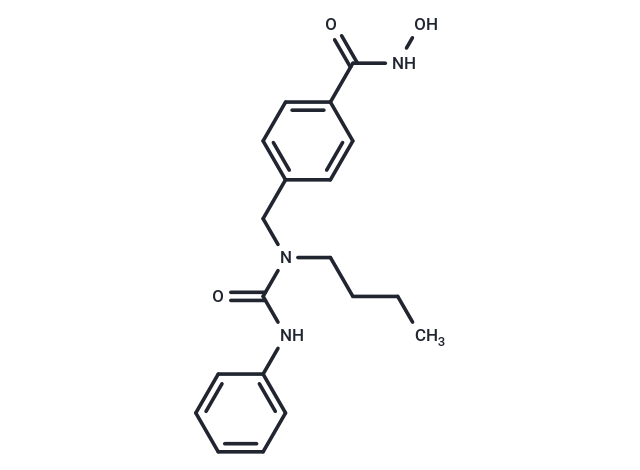Shopping Cart
- Remove All
 Your shopping cart is currently empty
Your shopping cart is currently empty


| Pack Size | Price | Availability | Quantity |
|---|---|---|---|
| 1 mg | $63 | In Stock | |
| 5 mg | $90 | In Stock | |
| 10 mg | $117 | In Stock | |
| 25 mg | $197 | In Stock | |
| 50 mg | $318 | In Stock | |
| 100 mg | $473 | In Stock | |
| 1 mL x 10 mM (in DMSO) | $71 | In Stock |
| Description | Nexturastat A is an effective and specific HDAC6 inhibitor (IC50: 5 nM). Its selectivity is >190-fold than other HDACs. |
| Targets&IC50 | HDAC6:5 nM |
| In vivo | Nexturastat A significantly inhibits the growth of B16 melanoma cells in mice, with a GI50 of 14.3 μM. In these cells, Nexturastat A dose-dependently increases the levels of acetylated α-tubulin without affecting the acetylation of histone H3 associated with abscesses. |
| Kinase Assay | HDAC inhibition assays: HDAC inhibition assays are performed by Reaction Biology Corp. using isolated human, recombinant full2length HDAC1 and -6 from a baculovirus expression system in Sf9 cells. An acetylated fluorogenic peptide,RHKKAc, derived from residues 379-382 of p53 is used as substrate. The reaction buffer is made up of 50 mM Tris-HCl pH 8.0, 127 mM NaCl, 2.7 mM KCl, 1 mM MgCl2, 1 mg/mL BSA, and a final concentration of 1% DMSO. Compounds are delivered in DMSO and delivered to enzyme mixture with preincubation of 5-10 min followed by substrate addition and incubation for 2 h at 30°C. Trichostatin A and developer are added to quench the reaction and generate fluorescence, respectively. Dose-response curves are generated starting at 30 μM compound with three-fold serial dilutions to generate a 10-dose plot. IC50 values are then generated from the resulting plots, and the values expressed are the average of duplicate trials ± standard deviation. |
| Cell Research | B16 murine melanoma cells are plated at 5000/well in 96 well flat bottom plates. The following day, media is changed to that containing various concentrations of HDACi or matched DMSO vehicle concentrations diluted in complete medium done in triplicate. Cells are incubated for 48 hours at 37°C and 5% CO2. Density of viable, metabolically active cells is quantified using a standard MTS assay as per manufacturer’s instructions. Briefly, 20μL of reagent are added per well and incubated at 37°C for 3 hours. Absorbances at 490 nM are measured spectrophotometrically with background subtraction at 690 nM. All values are then normalized and expressed as a percentage of medium control (100%). (Only for Reference) |
| Molecular Weight | 341.4 |
| Formula | C19H23N3O3 |
| Cas No. | 1403783-31-2 |
| Storage | Powder: -20°C for 3 years | In solvent: -80°C for 1 year | Shipping with blue ice. | ||||||||||||||||||||||||||||||||||||||||
| Solubility Information | DMSO: 63 mg/mL (184.5 mM) H2O: < 1 mg/mL (insoluble or slightly soluble) Ethanol: 2 mg/mL (5.85 mM) | ||||||||||||||||||||||||||||||||||||||||
Solution Preparation Table | |||||||||||||||||||||||||||||||||||||||||
Ethanol/DMSO
DMSO
| |||||||||||||||||||||||||||||||||||||||||

Copyright © 2015-2024 TargetMol Chemicals Inc. All Rights Reserved.